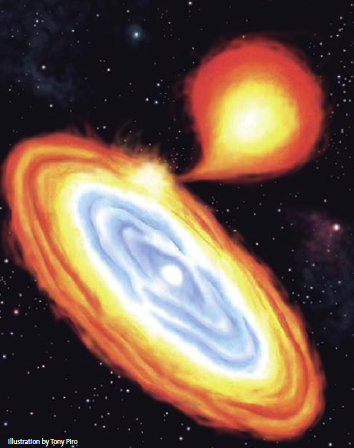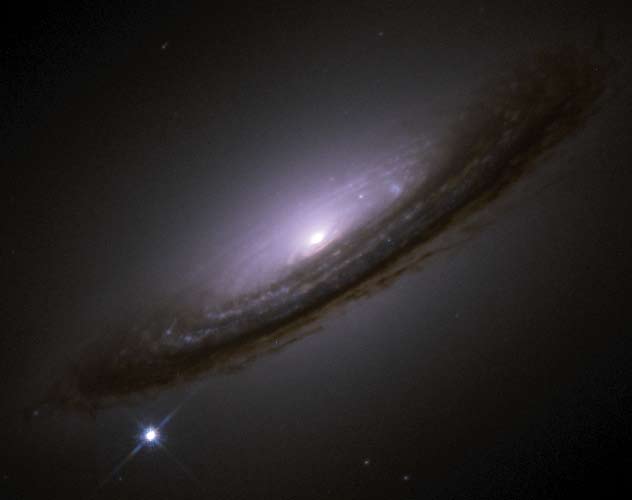 Artist's impression of mass transfer onto a white dwarf.
Artist's impression of mass transfer onto a white dwarf.
Illustration by Tony Piro.
In April of 1006 occurred the brightest stellar event so far in recorded history, visible for months at a time, on and off, for years afterward. According to Cairo astrologer Ali ibn Ridwan, “Its brightness was a little more than that of the quarter of the Moon.”
Almost exactly a thousand years later, astrophysicists and astronomers gathered at the Kavli Institute for Theoretical Physics in Santa Barbara to try better to understand the phenomenon exemplified by the 1006 event. That spectacular phenomenon — most probably the thermonuclear explosion of an elderly star known as a “white dwarf” — is called a “type Ia supernova.”
Such events occur close enough to be visible to an unaided observer on Earth about once every 200 years. As rare as they seem from the vantage of this planet, type Ia supernovae are quite common occurrences in the universe as a whole, with an estimated rate of one per second, according to astrophysicist Lars Bildsten, KITP permanent member and an organizer of the program “Accretion and Explosion: The Astrophysics of Degenerate Stars” (Jan. 29 to June 1, 2007).
There is a tradition at the KITP of blackboard luncheon talks on Mondays. Typically, two or three programs addressing very different scientific issues and attracting very different types of physicists run concurrently at the KITP. For the Monday blackboard talks, a presenter from one program pitches the talk so that scientists attending the other programs can readily grasp key questions perplexing colleagues in the presenter’s program.
Rosanne Di Stefano of the Harvard-Smithsonian Center for Astrophysics, another of the four supernova program organizers, ended her blackboard talk (on the dynamics of two possible star pairings conjectured to lead to Ia supernova events) by asking rhetorically, “Why care?” and herself answering, “Cosmology.”
This kind of supernova is the tool used by two teams of astronomers in the mid to late 1990s to make inadvertently what is surely one of the most momentous discoveries of the century. They found that the expansion rate of the universe is speeding up when most folks (including them) who had even thought about the expansion formulated by Hubble and Humason in 1929, thought it was slowing down.
 Supernova 1994D in Galaxy NGC 4526 from HubbleSite.org Credit: NASA, ESA, The Hubble Key Project Team, and The High-Z Supernova Search Team
Supernova 1994D in Galaxy NGC 4526 from HubbleSite.org Credit: NASA, ESA, The Hubble Key Project Team, and The High-Z Supernova Search Team
That finding in turn means that something counteracting the force of gravity, which is exerted by matter both ordinary (baryonic) and dark (yet to be identified), has to account for the speeding up, and that something, termed “dark energy,” turns out to make up 70 percent of the stuff in the universe.
Because Ia supernovae are so intrinsically bright (The death throes of one star are as bright as the billions of stars that make up a galaxy! See image above.), these supernovae can be seen from very far away and from very long ago.
The key cosmological time pinpointed by the supernovae is about five billion years ago, according to another of the program’s organizers Robert Kirshner, the Harvard astronomer who led one of the two supernovae search teams that discovered the accelerating expansion and its origin in dark energy.
The universe began to expand 14 or 15 billion years ago. Five billion years ago — at a redshift of 0.5 — the expansion rate turned from slowing down to speeding up. Until 10 years ago, no one had ever thought five billion years ago was a special time for the universe. It is about the same time, incidentally, that our Sun came into being and the solar system formed.
Bildsten, the theorist whose research focuses on the astrophysics of the supernovae themselves, and Kirshner, the observer for whom supernovae are tools, conceived the degenerate star program because, as Di Stefano pointed out, these death stars have of late revealed if not exactly “new heavens, new earth,” then a radically new way of looking at them. The lingering question is whether the billions-of-year-old supernovae occur in a similar context and are themselves enough similar to the nearby and more recent supernovae that have been well studied (if not well understood) to warrant the assumptions of similarity that make supernovae such powerful tools for cosmology.
